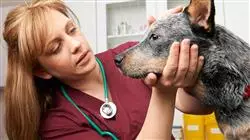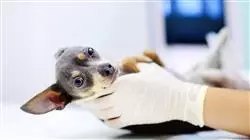University certificate
The world's largest faculty of veterinary medicine”
Introduction to the Program
Specialize in Orthopedic and Neurological Radiological Diagnosis and take advantage of the latest tools on offer to this field"

Diagnostic imaging tests are indispensable in the veterinary practice, becoming a common tool in the professional practice, as they allow them to make early diagnoses that can potentially save the lives of animals with certain conditions. Therefore, on this occasion, TECH offers an academic program prepared by a team of experts in the field that focuses on Orthopedic and Neurological Radiological Diagnosis in Small Animals .
In general, definitive diagnoses of central nervous system diseases require advanced imaging tests (CT and MRI), cerebrospinal fluid analysis and histopathological study (among others). However, in the case of some conditions it is possible to make an approximation to the diagnosis and, sometimes, a definitive diagnosis in the clinic through the use of simple radiography and myelography, as a complement to the rest of the diagnostic tests. Therefore, its study is of great value to any veterinarians looking to improve their level of training.
This program focuses on the field of orthopedics and traumatology, taking into account that the bone is a complex tissue and requires specialized knowledge to understand the fundamental functions. However, through the radiological method, specialized knowledge of the different conditions that may affect it can be developed.
In short, it is a program based on scientific evidence and daily practice, with all the nuances that each professional can contribute, enriched by the critical assessment that every professional must keep in mind.
Throughout this course, the student will learn about all the current approaches to the different challenges posed by their profession. A high-level step that will become a process of improvement, not only on a professional level, but also on a personal level. In addition, TECH assumes a social commitment: to help the updating of highly qualified professionals and to develop their personal, social and labor skills during the development of the same. And, to do so, it will not only take you through the theoretical knowledge offered, but will show you another way of studying and learning which is more organic, simpler and more efficient. It works to maintain motivation and to create a passion for learning; it encourages thinking and the development of critical thinking.
With this Postgraduate diploma we give you the opportunity to acquire superior training in Radiological Diagnosis so that it can be applied to the veterinary clinic"
This Postgraduate diploma in Orthopedic and Neurological Radiological Diagnosis in Small Animals contains the most complete and up-to-date educational program on the market. The most important features of the program include:
- The development of case studies presented by experts in Veterinary Radiology
- The graphic, schematic, and eminently practical contents with which they are created, provide scientific and practical information on the disciplines that are essential for professional practice
- Latest developments in Veterinary Radiology
- Practical exercises where self-assessment can be used to improve learning
- Special emphasis on innovative methodologies in Veterinary Radiology
- Theoretical lessons, questions to the expert, debate forums on controversial topics, and individual reflection assignments
- Content that is accessible from any fixed or portable device with an Internet connection
At TECH we help you to specialize in Orthopedic and Neurological Radiological Diagnosis in a simple way, thanks to our innovative methodology"
TECH's teaching staff includes professionals belonging to the veterinary field, who contribute their work experience to this training, as well as renowned specialists from reference societies and prestigious universities.
The Multimedia Content, elaborated with the latest Educational Technology, will allow professionals a situated and contextual learning, that is to say, a simulated environment that will provide an immersive specialization programmed to train in real situations.
This program is designed around Problem Based Learning, whereby the specialist must try to solve the different professional practice situations that arise during the academic year. For this purpose, the professional will be assisted by an innovative system of interactive videos made by renowned and experienced experts in Veterinary Radiology.
Our specialization, of high academic level, will allow you to achieve superior training in a short period of time"

Our online format will allow you to study in a comfortable way from wherever you choose"
Why study at TECH?
TECH is the world’s largest online university. With an impressive catalog of more than 14,000 university programs available in 11 languages, it is positioned as a leader in employability, with a 99% job placement rate. In addition, it relies on an enormous faculty of more than 6,000 professors of the highest international renown.

Study at the world's largest online university and guarantee your professional success. The future starts at TECH”
The world’s best online university according to FORBES
The prestigious Forbes magazine, specialized in business and finance, has highlighted TECH as “the world's best online university” This is what they have recently stated in an article in their digital edition in which they echo the success story of this institution, “thanks to the academic offer it provides, the selection of its teaching staff, and an innovative learning method aimed at educating the professionals of the future”
A revolutionary study method, a cutting-edge faculty and a practical focus: the key to TECH's success.
The most complete study plans on the university scene
TECH offers the most complete study plans on the university scene, with syllabuses that cover fundamental concepts and, at the same time, the main scientific advances in their specific scientific areas. In addition, these programs are continuously being updated to guarantee students the academic vanguard and the most in-demand professional skills. In this way, the university's qualifications provide its graduates with a significant advantage to propel their careers to success.
TECH offers the most comprehensive and intensive study plans on the current university scene.
A world-class teaching staff
TECH's teaching staff is made up of more than 6,000 professors with the highest international recognition. Professors, researchers and top executives of multinational companies, including Isaiah Covington, performance coach of the Boston Celtics; Magda Romanska, principal investigator at Harvard MetaLAB; Ignacio Wistumba, chairman of the department of translational molecular pathology at MD Anderson Cancer Center; and D.W. Pine, creative director of TIME magazine, among others.
Internationally renowned experts, specialized in different branches of Health, Technology, Communication and Business, form part of the TECH faculty.
A unique learning method
TECH is the first university to use Relearning in all its programs. It is the best online learning methodology, accredited with international teaching quality certifications, provided by prestigious educational agencies. In addition, this disruptive educational model is complemented with the “Case Method”, thereby setting up a unique online teaching strategy. Innovative teaching resources are also implemented, including detailed videos, infographics and interactive summaries.
TECH combines Relearning and the Case Method in all its university programs to guarantee excellent theoretical and practical learning, studying whenever and wherever you want.
The world's largest online university
TECH is the world’s largest online university. We are the largest educational institution, with the best and widest online educational catalog, one hundred percent online and covering the vast majority of areas of knowledge. We offer a large selection of our own degrees and accredited online undergraduate and postgraduate degrees. In total, more than 14,000 university degrees, in eleven different languages, make us the largest educational largest in the world.
TECH has the world's most extensive catalog of academic and official programs, available in more than 11 languages.
Google Premier Partner
The American technology giant has awarded TECH the Google Google Premier Partner badge. This award, which is only available to 3% of the world's companies, highlights the efficient, flexible and tailored experience that this university provides to students. The recognition as a Google Premier Partner not only accredits the maximum rigor, performance and investment in TECH's digital infrastructures, but also places this university as one of the world's leading technology companies.
Google has positioned TECH in the top 3% of the world's most important technology companies by awarding it its Google Premier Partner badge.
The official online university of the NBA
TECH is the official online university of the NBA. Thanks to our agreement with the biggest league in basketball, we offer our students exclusive university programs, as well as a wide variety of educational resources focused on the business of the league and other areas of the sports industry. Each program is made up of a uniquely designed syllabus and features exceptional guest hosts: professionals with a distinguished sports background who will offer their expertise on the most relevant topics.
TECH has been selected by the NBA, the world's top basketball league, as its official online university.
The top-rated university by its students
Students have positioned TECH as the world's top-rated university on the main review websites, with a highest rating of 4.9 out of 5, obtained from more than 1,000 reviews. These results consolidate TECH as the benchmark university institution at an international level, reflecting the excellence and positive impact of its educational model.” reflecting the excellence and positive impact of its educational model.”
TECH is the world’s top-rated university by its students.
Leaders in employability
TECH has managed to become the leading university in employability. 99% of its students obtain jobs in the academic field they have studied, within one year of completing any of the university's programs. A similar number achieve immediate career enhancement. All this thanks to a study methodology that bases its effectiveness on the acquisition of practical skills, which are absolutely necessary for professional development.
99% of TECH graduates find a job within a year of completing their studies.
Postgraduate Diploma in Orthopedic and Neurological Radiological Diagnosis in Small Animals
.
Veterinary professionals need to have effective tools to make accurate and early diagnoses in their animal patients, and Diagnostic Imaging tests are a fundamental part of their daily clinical practice. For this reason, a Postgraduate Diploma in Orthopedic and Neurological Radiological Diagnosis in Small Animals focused on radiological diagnosis in the field of Orthopedics, Traumatology and Neurology in small pets is presented.
Get up to date on the latest advances in this field by the hand of TECH
.
The Postgraduate Diploma in Orthopedic and Neurological Radiological Diagnosis in Small Animals is designed on the basis of scientific evidence and daily clinical practice, and has a team of experts in the field to ensure the quality of the preparation. Thus, participants will have access to high quality multimedia content, analysis of clinical cases, master classes and video techniques, which will allow them to get up to date with all the guarantees in Diagnostic Imaging in the veterinary field. In addition, the program is fully online, making it easy for them to organize their time and pace of study according to their schedules and needs.







